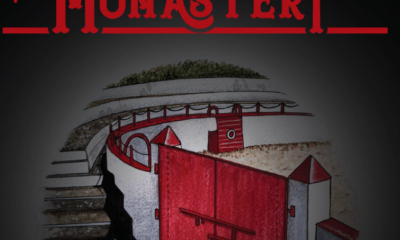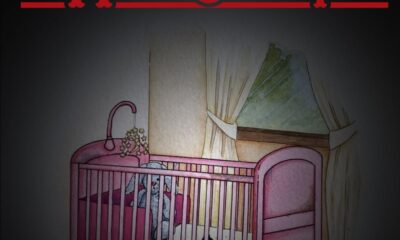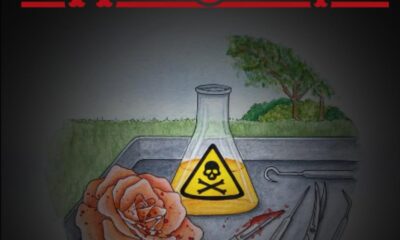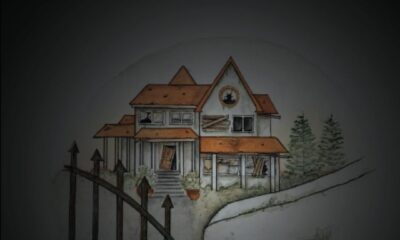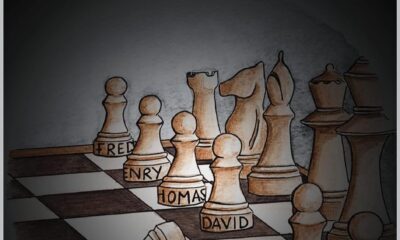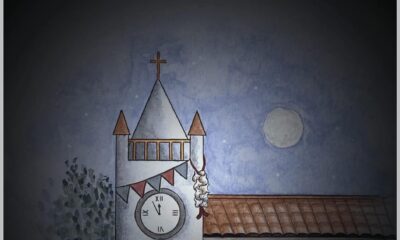
Monastery Series 5: a Book Review
I can’t believe we’re already at the mid-season finale of Monastery! Time indeed flies when you’re having a blast (or feel like you’ve been hit by a bag of bricks). The fifth installment of the novel is so action-packed I don’t even know where to start. All I will say right now is that we are in for a ride of a lifetime. Buckle up, folks.
Plot
We begin the episode with Thomas preparing to leave Monastery, a plan put in motion by his mother which is thankfully quickly reversed. Can you imagine anyone else leading the investigation? Didn’t think so. Although Thomas is still dealing with his guilt over Pop Dennis’s death, he knows there is a lot at stake. After all, his cousins need directions to get to the bottom of things.
For arguably the first time the group comes across something of great importance as they discover Francis’s DNA test. The group then trails him and our antagonist George Turner on their quest for the money Albert hid before his death. The characters encounter a bunch of clues that the narrator basically screams are foreshadowing but David once again disregards them. Nice going, man.
On the other end, we have an extremely disturbing scene involving Francis digging up his father’s grave and desecrating it. I don’t blame Nicole for throwing up at the sight. Seeing him getting more and more unhinged throughout the episode is unsettling as well as riveting.
Speaking of graves, we finally get a flashback sequence of the night Albert’s family covered up his murder. We still don’t know who committed the crime but can see who helped to bury the body aka who is complicit. The scene provides some great characterization to the adults of the ensemble cast. It also explains why George Turner is so involved in everything. Hell, it even manages to make me feel bad for Cassandra. Just for a moment, though.
Our neighborhood bully Rick continues to be heavily entangled in the story. He and Thomas have a highly emotional altercation when Rick attempts to take his own life. It’s a shame Rick doesn’t tell Thomas why he’s doing this as it would alleviate both their guilt. However, it’s also a realistic exploration of how young children handle something they are not emotionally equipped to deal with.
It is purely because of Thomas’s intentions to help him that Rick ends up being a witness to something horrible. Let’s just say, Francis finally snaps and George meets his brutal end. I definitely won’t miss the guy but this doesn’t bode well for our main cast. It can’t get any crazier though, right?
Overall thoughts
This is easily the most exhilarating episode of Monastery so far, with action just seeping off the pages. A lot of other storylines take a backseat (such as the love triangle that is seemingly dead but not quite). Despite that, there is still some time for emotional moments to let the readers take a breath. Words can’t say how excited I am for the next part. I just hope against all hope all my favorites will come out safe. Only time will tell…
 (5 / 5)
(5 / 5)
More from the author:
1. This episode of Monastery was probably the most morbid one yet (the flashback of the family covering up Albert’s murder, Francis digging up his body, Thomas climbing into his grave). What is your writing process when it comes to these types of scenes as they can be quite uncomfortable to think about?
I may well be a little unhinged, as I honestly love writing these morbid scenes – probably because they always feel like the reward you get after you’ve worked so hard for something, you know? As a writer, you try to build up to those big moments, so that they feel earned. My process then ties in with ensuring those big, morbid scenes aren’t gratuitous, that they make sense to the plot and the characters. The family covering up Albert’s murder comes from a place of despair and self-preservation; Francis digging up his body comes from a place of anguish and resentment, and Thomas, well, he’s a very driven young man who will stop at nothing to find the truth, and we’re only just beginning to see that.
2. The neighborhood bully Rick turned out to be a lot more integral to the story than I would’ve originally thought. What prompted you to connect a non-family character to the action to such extent and why him?
I always knew I wanted the regular cast to be an eclectic mix of characters – we have people of all generations of the family (from young Henry to nonagenarian Nana Beth), and even a couple of characters who aren’t family. There is no real reason for that, other than a quirk of mine. But Rick’s true purpose isn’t yet revealed – he just witnessed something immense, it now remains to be seen what he chooses to do about it…
3. I picked up on the theme of beauty throughout the installments of Monastery (especially Nicole and Cassandra’s interaction). Was this choice purely to provide some context for Cassandra’s character or to provide some social commentary about how beauty and youth are worshipped and as soon as a woman starts aging she’s discarded? Maybe a bit of a mix?
A little from column A, a little from column B. The commentary here ties in with the importance that the characters give to female beauty – Nicole is smart, resilient and courageous, but all everyone talks about is how beautiful she is, whereas Cassandra is often regarded as a former, faded beauty. Both women themselves attribute a lot of importance to beauty, an importance that was clearly hammered into them by the world around them. So, when we learn that Cassandra sacrificed her beauty to protect her family, it goes to show all that she was willing to sacrifice to keep her loved ones safe. She may not be grandma of the year – but she’s the hero of a lifetime. A really nasty, emotionally abusive hero, but a hero all the same!
Book Reviews
A Stellar Debut Novel, We Used To Live Here
Imagine this. You’re home alone, waiting for your partner to return, when you hear a knock on your door. You answer it to see a family of five, bundled up against the cold. The father, a kindly older gentleman, explains that he used to live in this house as a boy. And he would love to show it to his family.
Do not let them in.
The story
Released in June 2024, We Used To Live Here is author Marcus Kliewer’s debut novel. It tells the story of Eve, who just purchased a beautiful house with her partner, Charlie. Their plan is to flip the house and sell it.
One night, while waiting for Charlie to come home, Eve is surprised by a knock at the door. It’s a man named Thomas Faust and his family.
Thomas explains that he grew up in the house and hasn’t been in the area in years. Would Eve let them in so that he can show the home to his children?
Against her better judgment, Eve lets them in. She regrets this almost at once when Thomas’s daughter vanishes somewhere into the house.
What worked
I always appreciate a book that allows you to play along with the mystery. And this book does that better than just about any other I’ve seen.
Pay close attention to the chapters, to the words that aren’t there. To everything about this novel.
This is mostly down to Kliewer. This is ultimately his work of art. But the production value is also fantastic. I don’t want to ruin the multiple mysteries, so I’ll just say this. There are clues in this book that require some specific artistic choices in the page layouts in this book. And I loved that.
If you’d like to experience another horror book review, check out this one.
We Used To Live Here is also the kind of story that makes you question everything right along with the main character, Eve. Eve is a great main character. But she might be an unreliable narrator. She might be experiencing every single horror described, exactly as it’s described. Or, she might be having a psychotic breakdown. Through most of the book, we can’t be sure. And that is so much fun.
Finally, the weather plays a large part in this story. There are several stories in which the weather or the land itself could be considered a character. Even an antagonist. This is certainly one. The winter storm is the thing that traps the family in the house with Eve. It also makes escaping the home difficult. Reading this book during the winter was especially impactful. Most of us know what it feels like to be shut in by a storm. I’ve personally lived through some of those storms that are just referred to by their year, as though they were impactful enough to claim the whole 365 days for themself. And that was with people I liked. Imagine what it would feel like with strangers. It’s a staggering thought and one that we explore in depth in this book.
In the end, We Used To Live Here is a fantastic book. It’s the sort of story that sneaks into your brain and puts down roots. And if this is just the first book we’re getting from Kliewer, I can’t wait to see what else he comes up with.
 (5 / 5)
(5 / 5)
Book Reviews
Exploring real terror with The House of My Mother
As a disclaimer, this is a review of The House of My Mother from a critical perspective. I will not be discussing my opinions of the legal case against Ruby Franke and Jody Hildebrandt. I will be discussing the merits of the book as a work of true crime alone.
In 2015, Ruby Franke started a YouTube channel called 8 Passengers. In August of 2023, Franke and her business associate Jodi Hildebrandt were arrested for, and later plead guilty to, charges of aggravated child abuse. And in January of this year, Shari Franke told her story in The House of My Mother.
The story
The House of My Mother is the true story of Shari Franke, the oldest child of one of the most famous family vlogger families.
As a child, Shari came to the conclusion that her mother didn’t like her. Soon, she began to fear her mother’s anger.
Things got significantly worse when Ruby started their family vlog. All of the families most intimate moments were splashed across the internet for anyone to watch. This became a living nightmare for Shari.
Of course, that was only the start of the family nightmare. Because Ruby was about to meet someone who would reinforce all of the darkest parts of herself.
Eventually Shari manages to escape her home. But her younger siblings were still in her mother’s clutches. She had to save them, and her father, from the monster her mother had become.
What worked
Through the book, Shari only ever mentions the name of one of her siblings, Chad. This is because Chad is the only of her siblings that is an adult at the time of the publication.
There are children involved in this story. Children who’s lives and privacy have already been damaged. Shari didn’t want to do that to them again, and neither do I.
It probably won’t surprise you that this book is full of upsetting details. But not in the way you might imagine.
Nowhere in this book will you find gory details about the abuse the Franke kids suffered. And I consider that a good thing. Those sort of details are all fun and games when we’re talking fiction. When it’s real kids who are really living with the damage, it’s not a good time.
What you’ll find instead is a slew of more emotionally devastating moments. One that stuck with me is when Ruby’s mother gives her a pair of silk pajamas as a gift after Ruby gave birth to one of her babies. Shari asks Ruby if she’d bring her silk pajamas when she had a baby. Ruby responds that yes, when Shari becomes a mother they can be friends.
What a lovely way to make a little girl feel like she’s not worth anything unless she reproduces. And, if she does decide to have children, who is going to bring her silk pajamas?
In the end, this isn’t a story about ghosts or demons. It’s not about a serial killer waiting on a playground or in the attic of an unsuspecting family. Instead, this is a story about things that really keep us up at night. It’s the story of a woman so obsessed with perfection that she drove away her eldest daughter. The story of a young woman who’s forced to watch from afar as her beloved brothers and sisters are terrorized and abandoned. These are the sorts of things that really keep us up at night. These are the real nightmares.
More than that, though, The House of My Mother is a story of survival. It’s about a family that was ripped apart and somehow managed to stitch itself back together again. It’s about a brave young woman who managed to keep herself safe and sane in the face of a nightmare. If you haven’t read it yet, I can’t recommend it enough.
For more like this, check out my review of Shiny Happy People.
 (5 / 5)
(5 / 5)
Book Reviews
Book Review of Boreal: an Anthology of Taiga Horror
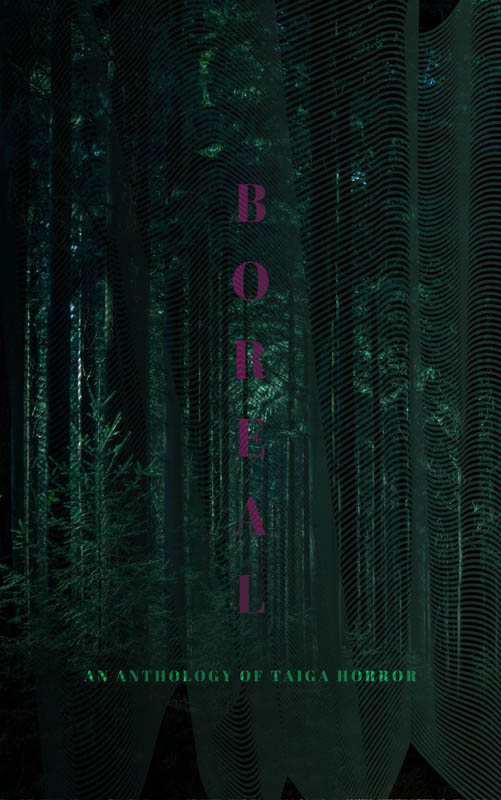
Boreal: an Anthology of Taiga Horror is a collection of twenty-two haunting tales that dwell in the deepest darkest woods and frozen wastelands, edited by Katherine Silva and including Haunted MTL’s very own Daphne Fauber. Each story has even been gifted with its very own poster, hinting at the horrors to be found within it, bestowing a beautiful visual collection as well.
The tales are varied and touch upon the environment in new and different ways, each hearkening to a sort of epiphany or raised awareness. These stories exude both dread and wonder at the smallness of our human existence in contrast to the sacred world we have isolated from, sheltering ourselves in our comfortable houses with centralized heat and everything we could possibly need or want at the ready. The taiga becomes a sanctuary outside of our own dulled awarenesses. It is a holy place imbued with powers beyond mortal human reach, a wilderness that threatens to swallow us – both whole and bit by bit, simultaneously.
The protagonists enter into this realm through ritual, superstition, longing, stubbornness, and their own hubris – yearning to survive its dangers, and to make their own marks upon it. The starkness of their surroundings harbors delicate moments that would be all too easily missed if not deliberately sought or pointed out. The softness of fur, the dappled sunlight shining through trees, the hazy clouds of breath forming in crisp air, the brittleness of bleached bone… those quiet experiences that beg to be forgotten, to lay safely sleeping just below the frozen surface, awaiting spring.
There are those who followed in the footsteps of their predecessors, seeking to escape the constraints of their parent’s and elders’ indoctrination, traditions, madness, and abuse, yearning to find their own way despite also being inextricably bound to their own pasts. There are those who just wanted to go for a walk in the woods, and remained forever changed by what they experienced. There are those who wished to impose their will upon the wilderness, their order falling to disarray, unable to make lasting impact. There are those who sought to leave behind the world of mankind, looking for oneness in the natural order of things through isolation, leaving a bit of themselves behind after being consumed by the terrors they encountered. There are those who truly found communion with the woods, became one with its wildness, and invited its spirit into their hearts to find peace, even at cost of their own lives. And then, there are the spirits themselves…
 (3 / 5)
(3 / 5)
All in all, I give Boreal: an Anthology of Taiga Horror 3.0 Cthulhus. I love existential angst so I found it to be an enjoyable read, and I appreciated the myriad manners in which the biome was explored. But there were points in which I found myself struggling to follow along, as if the words were swept up into their own wilds in ways that alienated myself as reader, as if my mere voyeurism into this otherworldly place was not enough to comprehend the subtle deviations in storytelling mannerisms fully. I suppose in some sense this seems appropriate, but at the same time, it left me feeling a bit unfulfilled, as if I had missed a spiritual connection that should have resonated more deeply.


